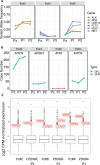From the identification of actionable molecular targets to the generation of faithful neuroblastoma patient-derived preclinical models
- PMID: 38351008
- PMCID: PMC10863144
- DOI: 10.1186/s12967-024-04954-w
From the identification of actionable molecular targets to the generation of faithful neuroblastoma patient-derived preclinical models
Abstract
Background: Neuroblastoma (NB) represents the most frequent and aggressive form of extracranial solid tumor of infants. Although the overall survival of patients with NB has improved in the last years, more than 50% of high-risk patients still undergo a relapse. Thus, in the era of precision/personalized medicine, the need for high-risk NB patient-specific therapies is urgent.
Methods: Within the PeRsonalizEd Medicine (PREME) program, patient-derived NB tumors and bone marrow (BM)-infiltrating NB cells, derived from either iliac crests or tumor bone lesions, underwent to histological and to flow cytometry immunophenotyping, respectively. BM samples containing a NB cells infiltration from 1 to 50 percent, underwent to a subsequent NB cells enrichment using immune-magnetic manipulation. Then, NB samples were used for the identification of actionable targets and for the generation of 3D/tumor-spheres and Patient-Derived Xenografts (PDX) and Cell PDX (CPDX) preclinical models.
Results: Eighty-four percent of NB-patients showed potentially therapeutically targetable somatic alterations (including point mutations, copy number variations and mRNA over-expression). Sixty-six percent of samples showed alterations, graded as "very high priority", that are validated to be directly targetable by an approved drug or an investigational agent. A molecular targeted therapy was applied for four patients, while a genetic counseling was suggested to two patients having one pathogenic germline variant in known cancer predisposition genes. Out of eleven samples implanted in mice, five gave rise to (C)PDX, all preserved in a local PDX Bio-bank. Interestingly, comparing all molecular alterations and histological and immunophenotypic features among the original patient's tumors and PDX/CPDX up to second generation, a high grade of similarity was observed. Notably, also 3D models conserved immunophenotypic features and molecular alterations of the original tumors.
Conclusions: PREME confirms the possibility of identifying targetable genomic alterations in NB, indeed, a molecular targeted therapy was applied to four NB patients. PREME paves the way to the creation of clinically relevant repositories of faithful patient-derived (C)PDX and 3D models, on which testing precision, NB standard-of-care and experimental medicines.
Keywords: Neuroblastoma; Precision medicine; Preclinical models, next generation sequencing; Target therapy.
© 2024. The Author(s).
Conflict of interest statement
The authors declare that they have no competing interests.
Figures





Similar articles
-
Cell surface Nucleolin represents a novel cellular target for neuroblastoma therapy.J Exp Clin Cancer Res. 2021 Jun 2;40(1):180. doi: 10.1186/s13046-021-01993-9. J Exp Clin Cancer Res. 2021. PMID: 34078433 Free PMC article.
-
Bone marrow-infiltrating human neuroblastoma cells express high levels of calprotectin and HLA-G proteins.PLoS One. 2012;7(1):e29922. doi: 10.1371/journal.pone.0029922. Epub 2012 Jan 9. PLoS One. 2012. PMID: 22253825 Free PMC article.
-
Italian Precision Medicine in Pediatric Oncology: Moving beyond Actionable Alterations.Int J Mol Sci. 2022 Sep 23;23(19):11236. doi: 10.3390/ijms231911236. Int J Mol Sci. 2022. PMID: 36232538 Free PMC article.
-
Patient-derived xenografts as preclinical neuroblastoma models.Cell Tissue Res. 2018 May;372(2):233-243. doi: 10.1007/s00441-017-2687-8. Epub 2017 Sep 19. Cell Tissue Res. 2018. PMID: 28924803 Free PMC article. Review.
-
Evaluation of bone marrow as a metastatic site of human neuroblastoma.Ann N Y Acad Sci. 2015 Jan;1335:23-31. doi: 10.1111/nyas.12554. Epub 2014 Oct 14. Ann N Y Acad Sci. 2015. PMID: 25315505 Review.
Cited by
-
Emerging clinical and research approaches in targeted therapies for high-risk neuroblastoma.Front Oncol. 2025 Mar 4;15:1553511. doi: 10.3389/fonc.2025.1553511. eCollection 2025. Front Oncol. 2025. PMID: 40104501 Free PMC article. Review.
-
Development of an alkaliptosis-related lncRNA risk model and immunotherapy target analysis in lung adenocarcinoma.Front Genet. 2025 Apr 8;16:1573480. doi: 10.3389/fgene.2025.1573480. eCollection 2025. Front Genet. 2025. PMID: 40264452 Free PMC article.
References
Publication types
MeSH terms
Grants and funding
LinkOut - more resources
Full Text Sources
Medical

